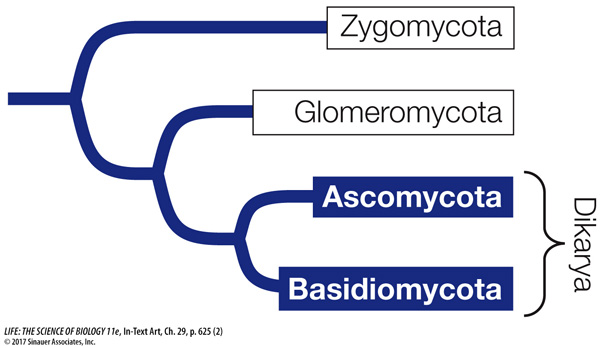The dikaryotic condition is a synapomorphy of sac fungi and club fungi
In the two remaining groups of fungi—the sac fungi and the club fungi—some stages have a nuclear configuration other than the familiar haploid or diploid states (Figure 29.17). In these fungi, karyogamy (fusion of nuclei) occurs long after plasmogamy (fusion of cytoplasm), so that two genetically different haploid nuclei coexist and divide within each cell of the mycelium. This stage of the life cycle is called a dikaryon (“two nuclei”), and its ploidy is indicated as n + n. The dikaryon is a synapomorphy of the sac fungi and club fungi, which are placed together in a clade called Dikarya.

Figure 29.17 Sexual Life Cycles among the Dikarya (A) In sac fungi, the products of meiosis are borne in a microscopic sac called an ascus. The fleshy fruiting structure, the ascoma, consists of both dikaryotic and haploid hyphae. (B) The basidium is the characteristic sexual reproductive structure of the club fungi. The fruiting structures, called basidiomata, consist solely of dikaryotic hyphae, and the dikaryotic phase can last a long time.
Question
Q: How does the dikaryotic condition differ from diploidy?
In the dikaryotic state, each cell contains a separate haploid nucleus from each parent. In the diploid state, the two nuclei are fused.
Activity 29.2 Life Cycle of a Dikaryotic Fungus
Eventually, specialized fruiting structures form, within which pairs of genetically dissimilar nuclei—one from each parent—fuse, giving rise to zygotes long after the original “mating.” The diploid zygote nucleus then undergoes meiosis, producing four haploid nuclei. The mitotic descendants of those nuclei become spores, which germinate to give rise to the next haploid generation.
A life cycle with a dikaryotic stage has several unusual features. First, there are no gamete cells, only gamete nuclei. Second, the only true diploid structure is the zygote, although for a long period the genes of both parents are present in the dikaryon and can be expressed. In effect, the dikaryon is neither diploid (2n) nor haploid (n). Rather, it is dikaryotic (n + n). Therefore a harmful recessive mutation in one nucleus may be compensated for by a normal allele on the same chromosome in the other nucleus, and dikaryotic hyphae often have characteristics that are different from their n or 2n products. The dikaryotic condition is perhaps the most distinctive of the genetic peculiarities of the fungi.

